Tourism Consumer Behaviour: Factors, Trends & Decision Process
VerifiedAdded on 2022/12/27
|11
|3665
|28
Report
AI Summary
This report delves into the multifaceted realm of tourism consumer behaviour, examining the cultural, social, personal, and psychological factors that shape consumer attitudes and decisions. It explores how digital technology is revolutionizing consumer trends, including contactless payments, AI chatbots, virtual reality tours, and a growing emphasis on sustainability. The report outlines the stages of the consumer decision-making journey, from need recognition to post-purchase behaviour, and highlights the benefits of mapping a path to purchase for tourism marketers. It also contrasts decision-making processes in B2B and B2C contexts, discusses various market research approaches, and evaluates how marketers can effectively influence each stage of the consumer decision-making process to enhance their strategies. Desklib provides a platform to access similar solved assignments and study resources for students.
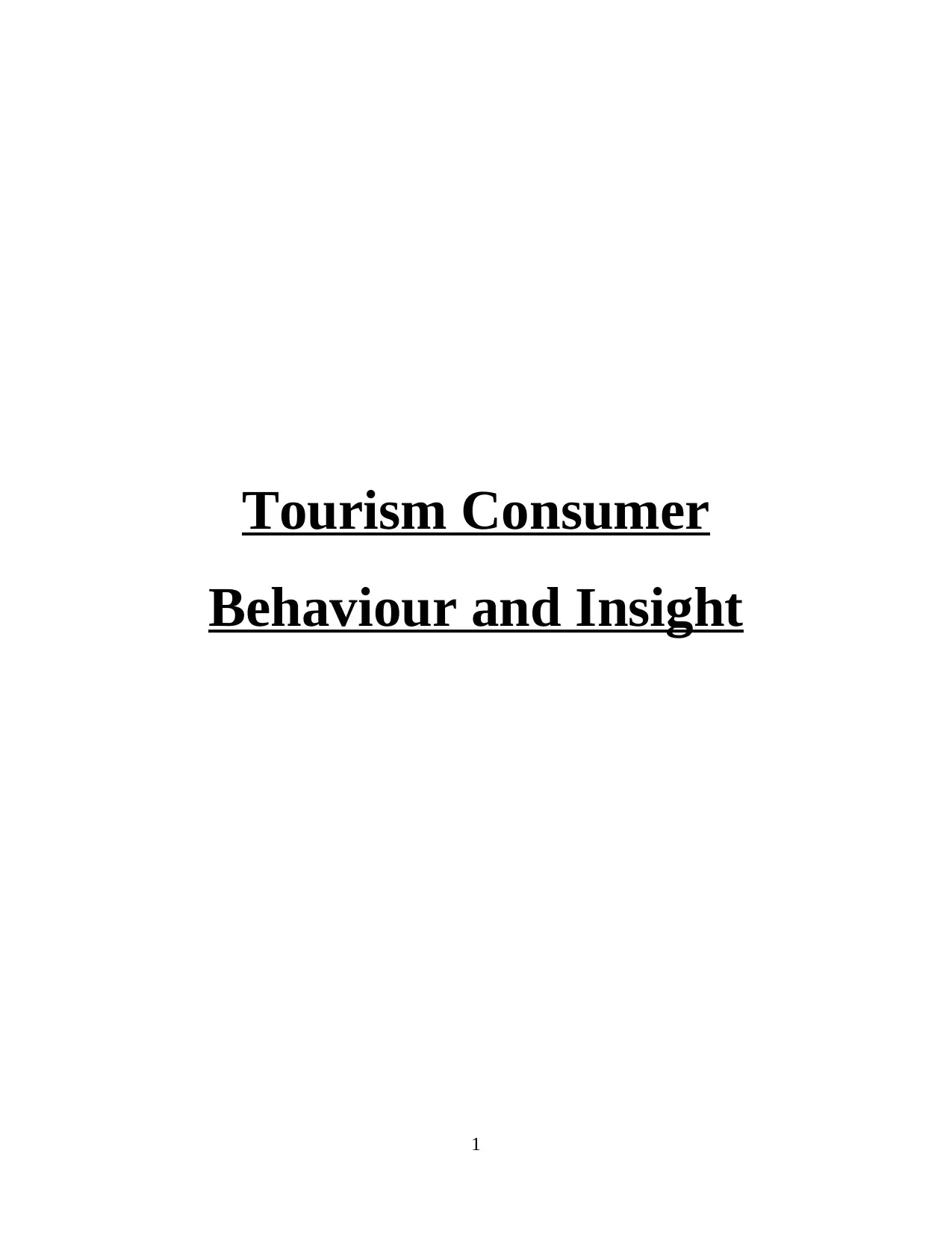
Tourism Consumer
Behaviour and Insight
1
Behaviour and Insight
1
Paraphrase This Document
Need a fresh take? Get an instant paraphrase of this document with our AI Paraphraser
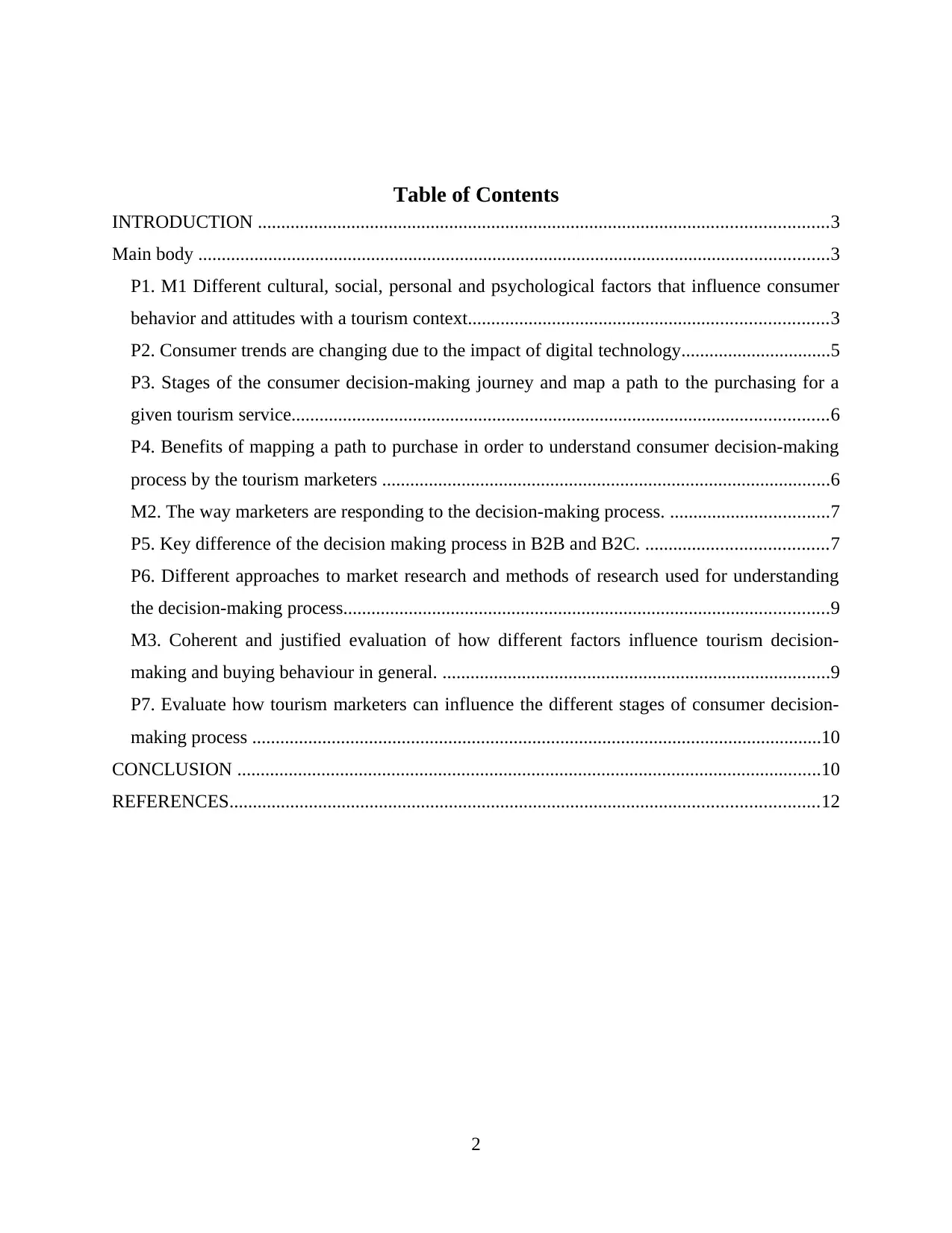
Table of Contents
INTRODUCTION ..........................................................................................................................3
Main body .......................................................................................................................................3
P1. M1 Different cultural, social, personal and psychological factors that influence consumer
behavior and attitudes with a tourism context.............................................................................3
P2. Consumer trends are changing due to the impact of digital technology................................5
P3. Stages of the consumer decision-making journey and map a path to the purchasing for a
given tourism service...................................................................................................................6
P4. Benefits of mapping a path to purchase in order to understand consumer decision-making
process by the tourism marketers ................................................................................................6
M2. The way marketers are responding to the decision-making process. ..................................7
P5. Key difference of the decision making process in B2B and B2C. .......................................7
P6. Different approaches to market research and methods of research used for understanding
the decision-making process........................................................................................................9
M3. Coherent and justified evaluation of how different factors influence tourism decision-
making and buying behaviour in general. ...................................................................................9
P7. Evaluate how tourism marketers can influence the different stages of consumer decision-
making process ..........................................................................................................................10
CONCLUSION .............................................................................................................................10
REFERENCES..............................................................................................................................12
2
INTRODUCTION ..........................................................................................................................3
Main body .......................................................................................................................................3
P1. M1 Different cultural, social, personal and psychological factors that influence consumer
behavior and attitudes with a tourism context.............................................................................3
P2. Consumer trends are changing due to the impact of digital technology................................5
P3. Stages of the consumer decision-making journey and map a path to the purchasing for a
given tourism service...................................................................................................................6
P4. Benefits of mapping a path to purchase in order to understand consumer decision-making
process by the tourism marketers ................................................................................................6
M2. The way marketers are responding to the decision-making process. ..................................7
P5. Key difference of the decision making process in B2B and B2C. .......................................7
P6. Different approaches to market research and methods of research used for understanding
the decision-making process........................................................................................................9
M3. Coherent and justified evaluation of how different factors influence tourism decision-
making and buying behaviour in general. ...................................................................................9
P7. Evaluate how tourism marketers can influence the different stages of consumer decision-
making process ..........................................................................................................................10
CONCLUSION .............................................................................................................................10
REFERENCES..............................................................................................................................12
2
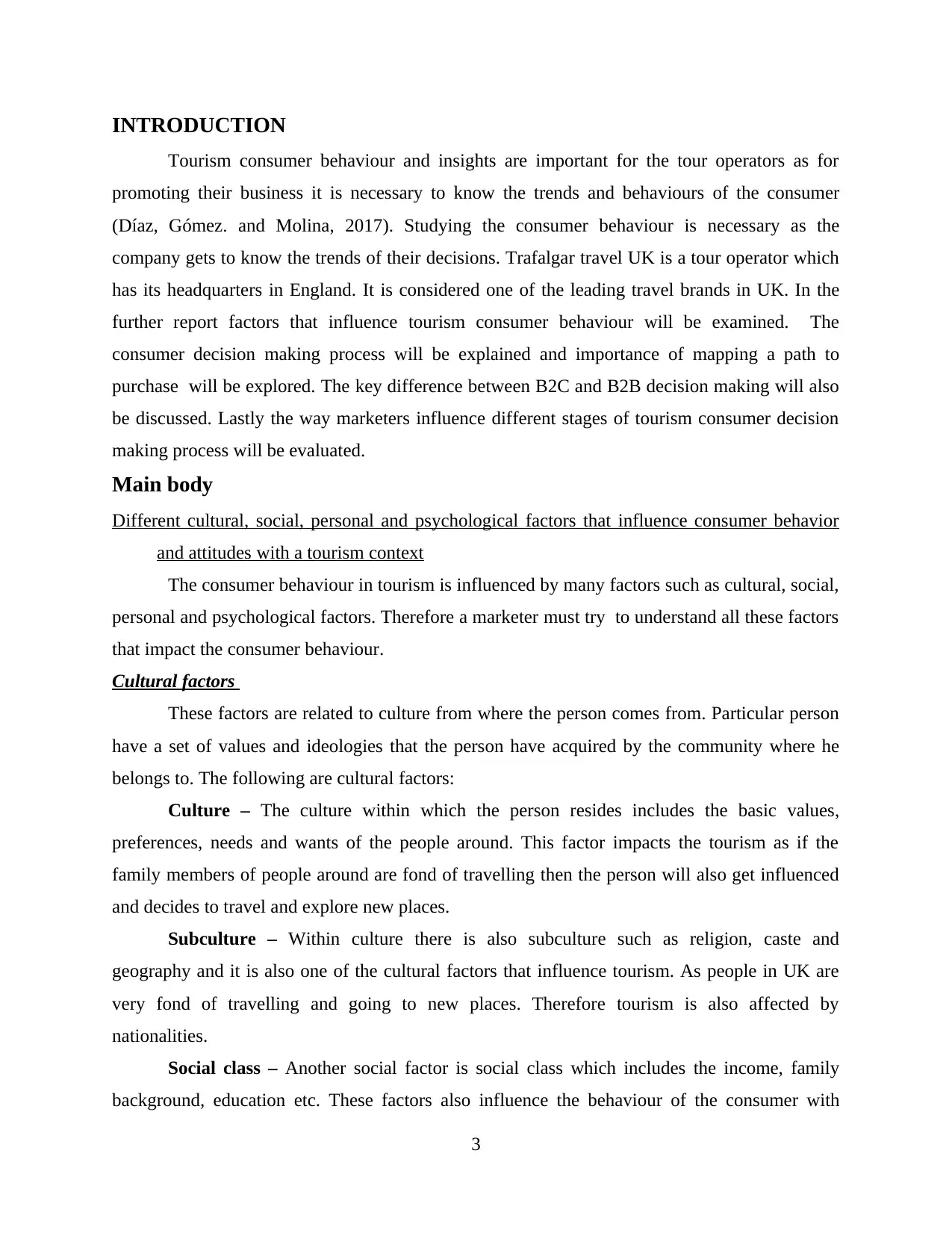
INTRODUCTION
Tourism consumer behaviour and insights are important for the tour operators as for
promoting their business it is necessary to know the trends and behaviours of the consumer
(Díaz, Gómez. and Molina, 2017). Studying the consumer behaviour is necessary as the
company gets to know the trends of their decisions. Trafalgar travel UK is a tour operator which
has its headquarters in England. It is considered one of the leading travel brands in UK. In the
further report factors that influence tourism consumer behaviour will be examined. The
consumer decision making process will be explained and importance of mapping a path to
purchase will be explored. The key difference between B2C and B2B decision making will also
be discussed. Lastly the way marketers influence different stages of tourism consumer decision
making process will be evaluated.
Main body
Different cultural, social, personal and psychological factors that influence consumer behavior
and attitudes with a tourism context
The consumer behaviour in tourism is influenced by many factors such as cultural, social,
personal and psychological factors. Therefore a marketer must try to understand all these factors
that impact the consumer behaviour.
Cultural factors
These factors are related to culture from where the person comes from. Particular person
have a set of values and ideologies that the person have acquired by the community where he
belongs to. The following are cultural factors:
Culture – The culture within which the person resides includes the basic values,
preferences, needs and wants of the people around. This factor impacts the tourism as if the
family members of people around are fond of travelling then the person will also get influenced
and decides to travel and explore new places.
Subculture – Within culture there is also subculture such as religion, caste and
geography and it is also one of the cultural factors that influence tourism. As people in UK are
very fond of travelling and going to new places. Therefore tourism is also affected by
nationalities.
Social class – Another social factor is social class which includes the income, family
background, education etc. These factors also influence the behaviour of the consumer with
3
Tourism consumer behaviour and insights are important for the tour operators as for
promoting their business it is necessary to know the trends and behaviours of the consumer
(Díaz, Gómez. and Molina, 2017). Studying the consumer behaviour is necessary as the
company gets to know the trends of their decisions. Trafalgar travel UK is a tour operator which
has its headquarters in England. It is considered one of the leading travel brands in UK. In the
further report factors that influence tourism consumer behaviour will be examined. The
consumer decision making process will be explained and importance of mapping a path to
purchase will be explored. The key difference between B2C and B2B decision making will also
be discussed. Lastly the way marketers influence different stages of tourism consumer decision
making process will be evaluated.
Main body
Different cultural, social, personal and psychological factors that influence consumer behavior
and attitudes with a tourism context
The consumer behaviour in tourism is influenced by many factors such as cultural, social,
personal and psychological factors. Therefore a marketer must try to understand all these factors
that impact the consumer behaviour.
Cultural factors
These factors are related to culture from where the person comes from. Particular person
have a set of values and ideologies that the person have acquired by the community where he
belongs to. The following are cultural factors:
Culture – The culture within which the person resides includes the basic values,
preferences, needs and wants of the people around. This factor impacts the tourism as if the
family members of people around are fond of travelling then the person will also get influenced
and decides to travel and explore new places.
Subculture – Within culture there is also subculture such as religion, caste and
geography and it is also one of the cultural factors that influence tourism. As people in UK are
very fond of travelling and going to new places. Therefore tourism is also affected by
nationalities.
Social class – Another social factor is social class which includes the income, family
background, education etc. These factors also influence the behaviour of the consumer with
3
⊘ This is a preview!⊘
Do you want full access?
Subscribe today to unlock all pages.

Trusted by 1+ million students worldwide
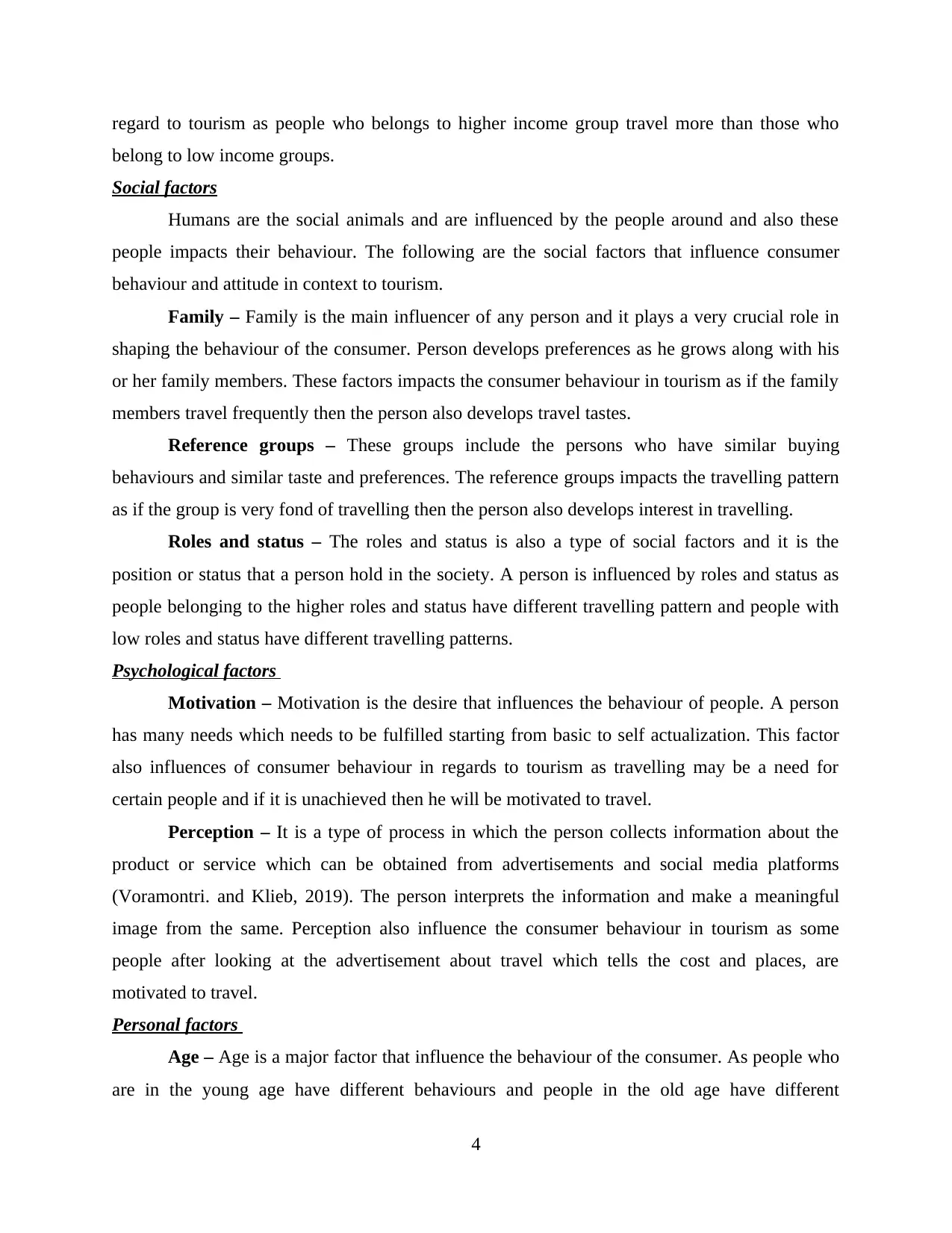
regard to tourism as people who belongs to higher income group travel more than those who
belong to low income groups.
Social factors
Humans are the social animals and are influenced by the people around and also these
people impacts their behaviour. The following are the social factors that influence consumer
behaviour and attitude in context to tourism.
Family – Family is the main influencer of any person and it plays a very crucial role in
shaping the behaviour of the consumer. Person develops preferences as he grows along with his
or her family members. These factors impacts the consumer behaviour in tourism as if the family
members travel frequently then the person also develops travel tastes.
Reference groups – These groups include the persons who have similar buying
behaviours and similar taste and preferences. The reference groups impacts the travelling pattern
as if the group is very fond of travelling then the person also develops interest in travelling.
Roles and status – The roles and status is also a type of social factors and it is the
position or status that a person hold in the society. A person is influenced by roles and status as
people belonging to the higher roles and status have different travelling pattern and people with
low roles and status have different travelling patterns.
Psychological factors
Motivation – Motivation is the desire that influences the behaviour of people. A person
has many needs which needs to be fulfilled starting from basic to self actualization. This factor
also influences of consumer behaviour in regards to tourism as travelling may be a need for
certain people and if it is unachieved then he will be motivated to travel.
Perception – It is a type of process in which the person collects information about the
product or service which can be obtained from advertisements and social media platforms
(Voramontri. and Klieb, 2019). The person interprets the information and make a meaningful
image from the same. Perception also influence the consumer behaviour in tourism as some
people after looking at the advertisement about travel which tells the cost and places, are
motivated to travel.
Personal factors
Age – Age is a major factor that influence the behaviour of the consumer. As people who
are in the young age have different behaviours and people in the old age have different
4
belong to low income groups.
Social factors
Humans are the social animals and are influenced by the people around and also these
people impacts their behaviour. The following are the social factors that influence consumer
behaviour and attitude in context to tourism.
Family – Family is the main influencer of any person and it plays a very crucial role in
shaping the behaviour of the consumer. Person develops preferences as he grows along with his
or her family members. These factors impacts the consumer behaviour in tourism as if the family
members travel frequently then the person also develops travel tastes.
Reference groups – These groups include the persons who have similar buying
behaviours and similar taste and preferences. The reference groups impacts the travelling pattern
as if the group is very fond of travelling then the person also develops interest in travelling.
Roles and status – The roles and status is also a type of social factors and it is the
position or status that a person hold in the society. A person is influenced by roles and status as
people belonging to the higher roles and status have different travelling pattern and people with
low roles and status have different travelling patterns.
Psychological factors
Motivation – Motivation is the desire that influences the behaviour of people. A person
has many needs which needs to be fulfilled starting from basic to self actualization. This factor
also influences of consumer behaviour in regards to tourism as travelling may be a need for
certain people and if it is unachieved then he will be motivated to travel.
Perception – It is a type of process in which the person collects information about the
product or service which can be obtained from advertisements and social media platforms
(Voramontri. and Klieb, 2019). The person interprets the information and make a meaningful
image from the same. Perception also influence the consumer behaviour in tourism as some
people after looking at the advertisement about travel which tells the cost and places, are
motivated to travel.
Personal factors
Age – Age is a major factor that influence the behaviour of the consumer. As people who
are in the young age have different behaviours and people in the old age have different
4
Paraphrase This Document
Need a fresh take? Get an instant paraphrase of this document with our AI Paraphraser
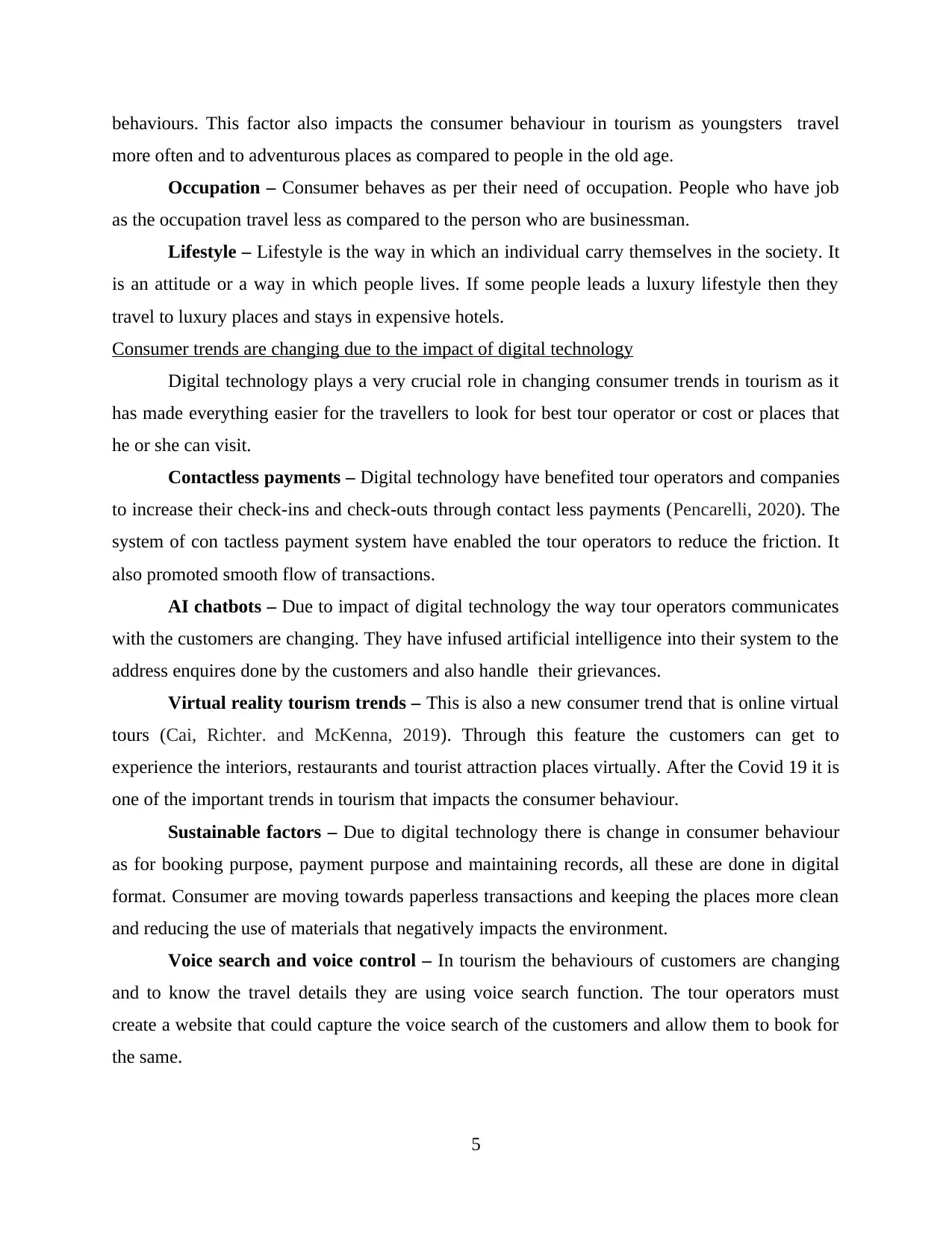
behaviours. This factor also impacts the consumer behaviour in tourism as youngsters travel
more often and to adventurous places as compared to people in the old age.
Occupation – Consumer behaves as per their need of occupation. People who have job
as the occupation travel less as compared to the person who are businessman.
Lifestyle – Lifestyle is the way in which an individual carry themselves in the society. It
is an attitude or a way in which people lives. If some people leads a luxury lifestyle then they
travel to luxury places and stays in expensive hotels.
Consumer trends are changing due to the impact of digital technology
Digital technology plays a very crucial role in changing consumer trends in tourism as it
has made everything easier for the travellers to look for best tour operator or cost or places that
he or she can visit.
Contactless payments – Digital technology have benefited tour operators and companies
to increase their check-ins and check-outs through contact less payments (Pencarelli, 2020). The
system of con tactless payment system have enabled the tour operators to reduce the friction. It
also promoted smooth flow of transactions.
AI chatbots – Due to impact of digital technology the way tour operators communicates
with the customers are changing. They have infused artificial intelligence into their system to the
address enquires done by the customers and also handle their grievances.
Virtual reality tourism trends – This is also a new consumer trend that is online virtual
tours (Cai, Richter. and McKenna, 2019). Through this feature the customers can get to
experience the interiors, restaurants and tourist attraction places virtually. After the Covid 19 it is
one of the important trends in tourism that impacts the consumer behaviour.
Sustainable factors – Due to digital technology there is change in consumer behaviour
as for booking purpose, payment purpose and maintaining records, all these are done in digital
format. Consumer are moving towards paperless transactions and keeping the places more clean
and reducing the use of materials that negatively impacts the environment.
Voice search and voice control – In tourism the behaviours of customers are changing
and to know the travel details they are using voice search function. The tour operators must
create a website that could capture the voice search of the customers and allow them to book for
the same.
5
more often and to adventurous places as compared to people in the old age.
Occupation – Consumer behaves as per their need of occupation. People who have job
as the occupation travel less as compared to the person who are businessman.
Lifestyle – Lifestyle is the way in which an individual carry themselves in the society. It
is an attitude or a way in which people lives. If some people leads a luxury lifestyle then they
travel to luxury places and stays in expensive hotels.
Consumer trends are changing due to the impact of digital technology
Digital technology plays a very crucial role in changing consumer trends in tourism as it
has made everything easier for the travellers to look for best tour operator or cost or places that
he or she can visit.
Contactless payments – Digital technology have benefited tour operators and companies
to increase their check-ins and check-outs through contact less payments (Pencarelli, 2020). The
system of con tactless payment system have enabled the tour operators to reduce the friction. It
also promoted smooth flow of transactions.
AI chatbots – Due to impact of digital technology the way tour operators communicates
with the customers are changing. They have infused artificial intelligence into their system to the
address enquires done by the customers and also handle their grievances.
Virtual reality tourism trends – This is also a new consumer trend that is online virtual
tours (Cai, Richter. and McKenna, 2019). Through this feature the customers can get to
experience the interiors, restaurants and tourist attraction places virtually. After the Covid 19 it is
one of the important trends in tourism that impacts the consumer behaviour.
Sustainable factors – Due to digital technology there is change in consumer behaviour
as for booking purpose, payment purpose and maintaining records, all these are done in digital
format. Consumer are moving towards paperless transactions and keeping the places more clean
and reducing the use of materials that negatively impacts the environment.
Voice search and voice control – In tourism the behaviours of customers are changing
and to know the travel details they are using voice search function. The tour operators must
create a website that could capture the voice search of the customers and allow them to book for
the same.
5
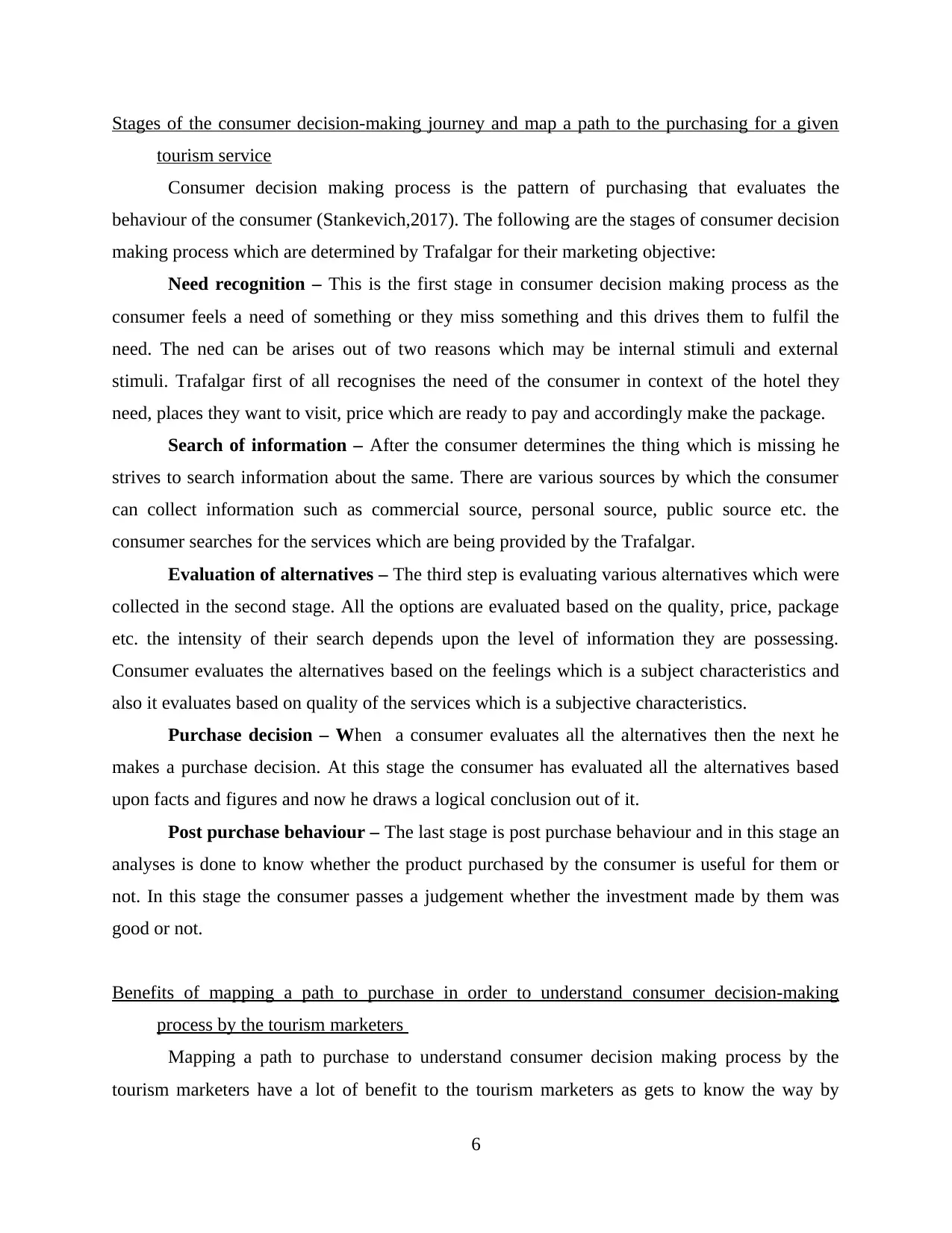
Stages of the consumer decision-making journey and map a path to the purchasing for a given
tourism service
Consumer decision making process is the pattern of purchasing that evaluates the
behaviour of the consumer (Stankevich,2017). The following are the stages of consumer decision
making process which are determined by Trafalgar for their marketing objective:
Need recognition – This is the first stage in consumer decision making process as the
consumer feels a need of something or they miss something and this drives them to fulfil the
need. The ned can be arises out of two reasons which may be internal stimuli and external
stimuli. Trafalgar first of all recognises the need of the consumer in context of the hotel they
need, places they want to visit, price which are ready to pay and accordingly make the package.
Search of information – After the consumer determines the thing which is missing he
strives to search information about the same. There are various sources by which the consumer
can collect information such as commercial source, personal source, public source etc. the
consumer searches for the services which are being provided by the Trafalgar.
Evaluation of alternatives – The third step is evaluating various alternatives which were
collected in the second stage. All the options are evaluated based on the quality, price, package
etc. the intensity of their search depends upon the level of information they are possessing.
Consumer evaluates the alternatives based on the feelings which is a subject characteristics and
also it evaluates based on quality of the services which is a subjective characteristics.
Purchase decision – When a consumer evaluates all the alternatives then the next he
makes a purchase decision. At this stage the consumer has evaluated all the alternatives based
upon facts and figures and now he draws a logical conclusion out of it.
Post purchase behaviour – The last stage is post purchase behaviour and in this stage an
analyses is done to know whether the product purchased by the consumer is useful for them or
not. In this stage the consumer passes a judgement whether the investment made by them was
good or not.
Benefits of mapping a path to purchase in order to understand consumer decision-making
process by the tourism marketers
Mapping a path to purchase to understand consumer decision making process by the
tourism marketers have a lot of benefit to the tourism marketers as gets to know the way by
6
tourism service
Consumer decision making process is the pattern of purchasing that evaluates the
behaviour of the consumer (Stankevich,2017). The following are the stages of consumer decision
making process which are determined by Trafalgar for their marketing objective:
Need recognition – This is the first stage in consumer decision making process as the
consumer feels a need of something or they miss something and this drives them to fulfil the
need. The ned can be arises out of two reasons which may be internal stimuli and external
stimuli. Trafalgar first of all recognises the need of the consumer in context of the hotel they
need, places they want to visit, price which are ready to pay and accordingly make the package.
Search of information – After the consumer determines the thing which is missing he
strives to search information about the same. There are various sources by which the consumer
can collect information such as commercial source, personal source, public source etc. the
consumer searches for the services which are being provided by the Trafalgar.
Evaluation of alternatives – The third step is evaluating various alternatives which were
collected in the second stage. All the options are evaluated based on the quality, price, package
etc. the intensity of their search depends upon the level of information they are possessing.
Consumer evaluates the alternatives based on the feelings which is a subject characteristics and
also it evaluates based on quality of the services which is a subjective characteristics.
Purchase decision – When a consumer evaluates all the alternatives then the next he
makes a purchase decision. At this stage the consumer has evaluated all the alternatives based
upon facts and figures and now he draws a logical conclusion out of it.
Post purchase behaviour – The last stage is post purchase behaviour and in this stage an
analyses is done to know whether the product purchased by the consumer is useful for them or
not. In this stage the consumer passes a judgement whether the investment made by them was
good or not.
Benefits of mapping a path to purchase in order to understand consumer decision-making
process by the tourism marketers
Mapping a path to purchase to understand consumer decision making process by the
tourism marketers have a lot of benefit to the tourism marketers as gets to know the way by
6
⊘ This is a preview!⊘
Do you want full access?
Subscribe today to unlock all pages.

Trusted by 1+ million students worldwide
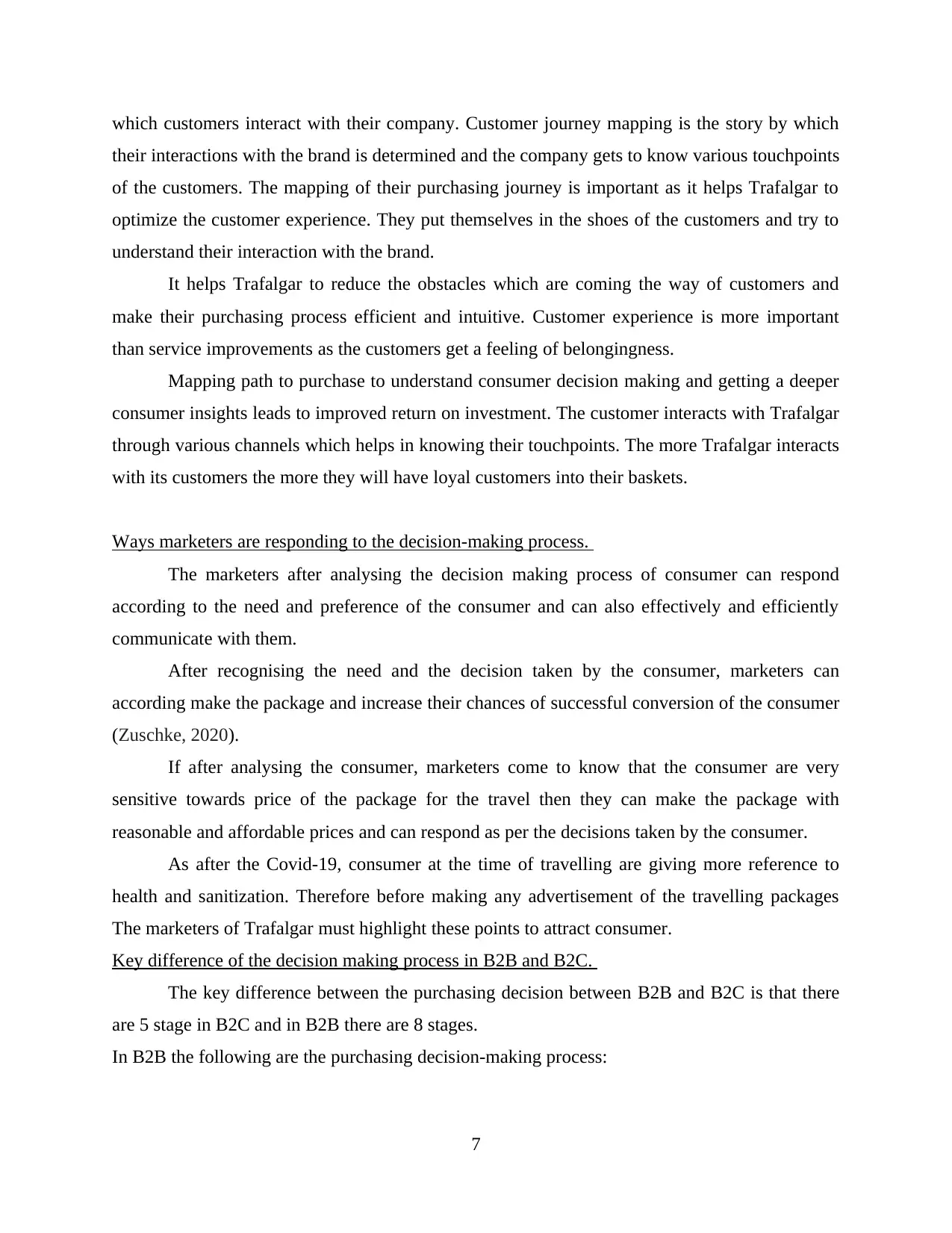
which customers interact with their company. Customer journey mapping is the story by which
their interactions with the brand is determined and the company gets to know various touchpoints
of the customers. The mapping of their purchasing journey is important as it helps Trafalgar to
optimize the customer experience. They put themselves in the shoes of the customers and try to
understand their interaction with the brand.
It helps Trafalgar to reduce the obstacles which are coming the way of customers and
make their purchasing process efficient and intuitive. Customer experience is more important
than service improvements as the customers get a feeling of belongingness.
Mapping path to purchase to understand consumer decision making and getting a deeper
consumer insights leads to improved return on investment. The customer interacts with Trafalgar
through various channels which helps in knowing their touchpoints. The more Trafalgar interacts
with its customers the more they will have loyal customers into their baskets.
Ways marketers are responding to the decision-making process.
The marketers after analysing the decision making process of consumer can respond
according to the need and preference of the consumer and can also effectively and efficiently
communicate with them.
After recognising the need and the decision taken by the consumer, marketers can
according make the package and increase their chances of successful conversion of the consumer
(Zuschke, 2020).
If after analysing the consumer, marketers come to know that the consumer are very
sensitive towards price of the package for the travel then they can make the package with
reasonable and affordable prices and can respond as per the decisions taken by the consumer.
As after the Covid-19, consumer at the time of travelling are giving more reference to
health and sanitization. Therefore before making any advertisement of the travelling packages
The marketers of Trafalgar must highlight these points to attract consumer.
Key difference of the decision making process in B2B and B2C.
The key difference between the purchasing decision between B2B and B2C is that there
are 5 stage in B2C and in B2B there are 8 stages.
In B2B the following are the purchasing decision-making process:
7
their interactions with the brand is determined and the company gets to know various touchpoints
of the customers. The mapping of their purchasing journey is important as it helps Trafalgar to
optimize the customer experience. They put themselves in the shoes of the customers and try to
understand their interaction with the brand.
It helps Trafalgar to reduce the obstacles which are coming the way of customers and
make their purchasing process efficient and intuitive. Customer experience is more important
than service improvements as the customers get a feeling of belongingness.
Mapping path to purchase to understand consumer decision making and getting a deeper
consumer insights leads to improved return on investment. The customer interacts with Trafalgar
through various channels which helps in knowing their touchpoints. The more Trafalgar interacts
with its customers the more they will have loyal customers into their baskets.
Ways marketers are responding to the decision-making process.
The marketers after analysing the decision making process of consumer can respond
according to the need and preference of the consumer and can also effectively and efficiently
communicate with them.
After recognising the need and the decision taken by the consumer, marketers can
according make the package and increase their chances of successful conversion of the consumer
(Zuschke, 2020).
If after analysing the consumer, marketers come to know that the consumer are very
sensitive towards price of the package for the travel then they can make the package with
reasonable and affordable prices and can respond as per the decisions taken by the consumer.
As after the Covid-19, consumer at the time of travelling are giving more reference to
health and sanitization. Therefore before making any advertisement of the travelling packages
The marketers of Trafalgar must highlight these points to attract consumer.
Key difference of the decision making process in B2B and B2C.
The key difference between the purchasing decision between B2B and B2C is that there
are 5 stage in B2C and in B2B there are 8 stages.
In B2B the following are the purchasing decision-making process:
7
Paraphrase This Document
Need a fresh take? Get an instant paraphrase of this document with our AI Paraphraser
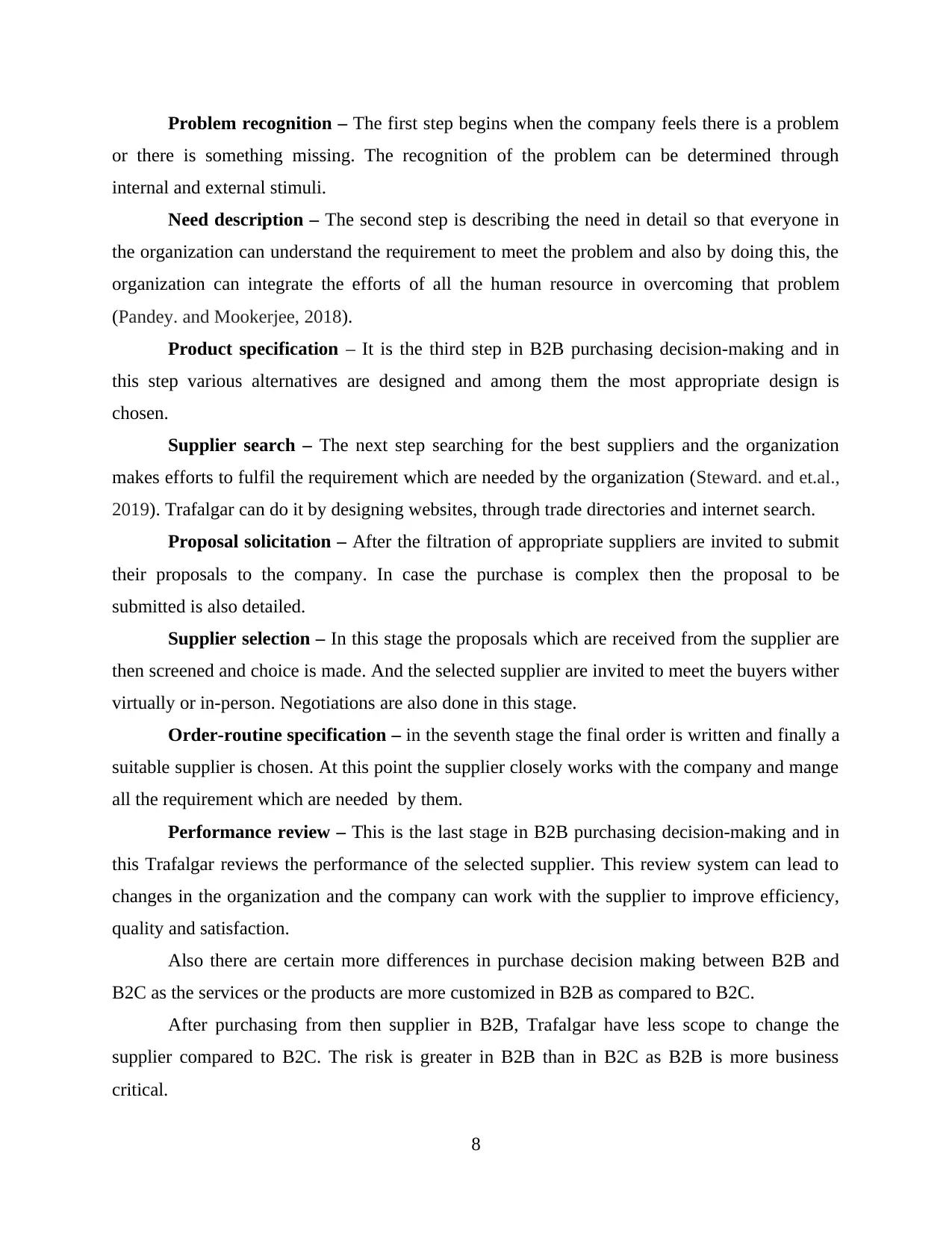
Problem recognition – The first step begins when the company feels there is a problem
or there is something missing. The recognition of the problem can be determined through
internal and external stimuli.
Need description – The second step is describing the need in detail so that everyone in
the organization can understand the requirement to meet the problem and also by doing this, the
organization can integrate the efforts of all the human resource in overcoming that problem
(Pandey. and Mookerjee, 2018).
Product specification – It is the third step in B2B purchasing decision-making and in
this step various alternatives are designed and among them the most appropriate design is
chosen.
Supplier search – The next step searching for the best suppliers and the organization
makes efforts to fulfil the requirement which are needed by the organization (Steward. and et.al.,
2019). Trafalgar can do it by designing websites, through trade directories and internet search.
Proposal solicitation – After the filtration of appropriate suppliers are invited to submit
their proposals to the company. In case the purchase is complex then the proposal to be
submitted is also detailed.
Supplier selection – In this stage the proposals which are received from the supplier are
then screened and choice is made. And the selected supplier are invited to meet the buyers wither
virtually or in-person. Negotiations are also done in this stage.
Order-routine specification – in the seventh stage the final order is written and finally a
suitable supplier is chosen. At this point the supplier closely works with the company and mange
all the requirement which are needed by them.
Performance review – This is the last stage in B2B purchasing decision-making and in
this Trafalgar reviews the performance of the selected supplier. This review system can lead to
changes in the organization and the company can work with the supplier to improve efficiency,
quality and satisfaction.
Also there are certain more differences in purchase decision making between B2B and
B2C as the services or the products are more customized in B2B as compared to B2C.
After purchasing from then supplier in B2B, Trafalgar have less scope to change the
supplier compared to B2C. The risk is greater in B2B than in B2C as B2B is more business
critical.
8
or there is something missing. The recognition of the problem can be determined through
internal and external stimuli.
Need description – The second step is describing the need in detail so that everyone in
the organization can understand the requirement to meet the problem and also by doing this, the
organization can integrate the efforts of all the human resource in overcoming that problem
(Pandey. and Mookerjee, 2018).
Product specification – It is the third step in B2B purchasing decision-making and in
this step various alternatives are designed and among them the most appropriate design is
chosen.
Supplier search – The next step searching for the best suppliers and the organization
makes efforts to fulfil the requirement which are needed by the organization (Steward. and et.al.,
2019). Trafalgar can do it by designing websites, through trade directories and internet search.
Proposal solicitation – After the filtration of appropriate suppliers are invited to submit
their proposals to the company. In case the purchase is complex then the proposal to be
submitted is also detailed.
Supplier selection – In this stage the proposals which are received from the supplier are
then screened and choice is made. And the selected supplier are invited to meet the buyers wither
virtually or in-person. Negotiations are also done in this stage.
Order-routine specification – in the seventh stage the final order is written and finally a
suitable supplier is chosen. At this point the supplier closely works with the company and mange
all the requirement which are needed by them.
Performance review – This is the last stage in B2B purchasing decision-making and in
this Trafalgar reviews the performance of the selected supplier. This review system can lead to
changes in the organization and the company can work with the supplier to improve efficiency,
quality and satisfaction.
Also there are certain more differences in purchase decision making between B2B and
B2C as the services or the products are more customized in B2B as compared to B2C.
After purchasing from then supplier in B2B, Trafalgar have less scope to change the
supplier compared to B2C. The risk is greater in B2B than in B2C as B2B is more business
critical.
8

Different approaches to market research and methods of research used for understanding the
decision-making process
For understanding the decision making process it is necessary to undertake market
research properly as the information which is collected can hamper the quality of it. The
following are types of market research that can be conducted to understand the decision-making
process are:
Quantitative market research – In this type of research the data which is to be
collected, is in the form of facts and figures or may be charts (Dutta. and Bhattacharya, 2018).
Trafalgar analyse the collected data and makes the decision accordingly. Through this research,
the company also takes into account various challenges.
Qualitative market research – In this type of market research the company tries to find
out the thinking, feelings and other aspects of the consumer behaviour and also Trafalgar finds
out what motivates the consumer. As the data is not in figures therefore the researcher have to
undertake in-depth understanding as it give a deeper insights into consumer behaviour (Pierre,
2017) . By doing this Trafalgar can address the needs and expectations of their target customer
more efficiently.
Social media research – Another approach of doing the research is through social media
platforms such as Facebook, Twitter, Instagram etc. Collecting data through these platforms
helps Trafalgar in increasing their scope of research as they will get majority of the information
as most of the target customers are active of these platforms.
Online surveys – Also Trafalgar can conduct an online survey to collect the data about
their taste and preferences. By conducting the online surveys, the tour operators can frame the
campaigns and strategies to stimulate the consumer to take the services provided by Trafalgar.
Coherent and justified evaluation of different factors influence tourism decision-making and
buying behaviour in general.
Psychological factors – Psychological factors influence the decision making of the
tourists and their buying behaviour as these are the inborn traits and they take decision based in
the psychology. As certain people like to travel to a luxurious place while some prefers to travel
for adventure therefore the psychological factors influence tourism decision making.
9
decision-making process
For understanding the decision making process it is necessary to undertake market
research properly as the information which is collected can hamper the quality of it. The
following are types of market research that can be conducted to understand the decision-making
process are:
Quantitative market research – In this type of research the data which is to be
collected, is in the form of facts and figures or may be charts (Dutta. and Bhattacharya, 2018).
Trafalgar analyse the collected data and makes the decision accordingly. Through this research,
the company also takes into account various challenges.
Qualitative market research – In this type of market research the company tries to find
out the thinking, feelings and other aspects of the consumer behaviour and also Trafalgar finds
out what motivates the consumer. As the data is not in figures therefore the researcher have to
undertake in-depth understanding as it give a deeper insights into consumer behaviour (Pierre,
2017) . By doing this Trafalgar can address the needs and expectations of their target customer
more efficiently.
Social media research – Another approach of doing the research is through social media
platforms such as Facebook, Twitter, Instagram etc. Collecting data through these platforms
helps Trafalgar in increasing their scope of research as they will get majority of the information
as most of the target customers are active of these platforms.
Online surveys – Also Trafalgar can conduct an online survey to collect the data about
their taste and preferences. By conducting the online surveys, the tour operators can frame the
campaigns and strategies to stimulate the consumer to take the services provided by Trafalgar.
Coherent and justified evaluation of different factors influence tourism decision-making and
buying behaviour in general.
Psychological factors – Psychological factors influence the decision making of the
tourists and their buying behaviour as these are the inborn traits and they take decision based in
the psychology. As certain people like to travel to a luxurious place while some prefers to travel
for adventure therefore the psychological factors influence tourism decision making.
9
⊘ This is a preview!⊘
Do you want full access?
Subscribe today to unlock all pages.

Trusted by 1+ million students worldwide
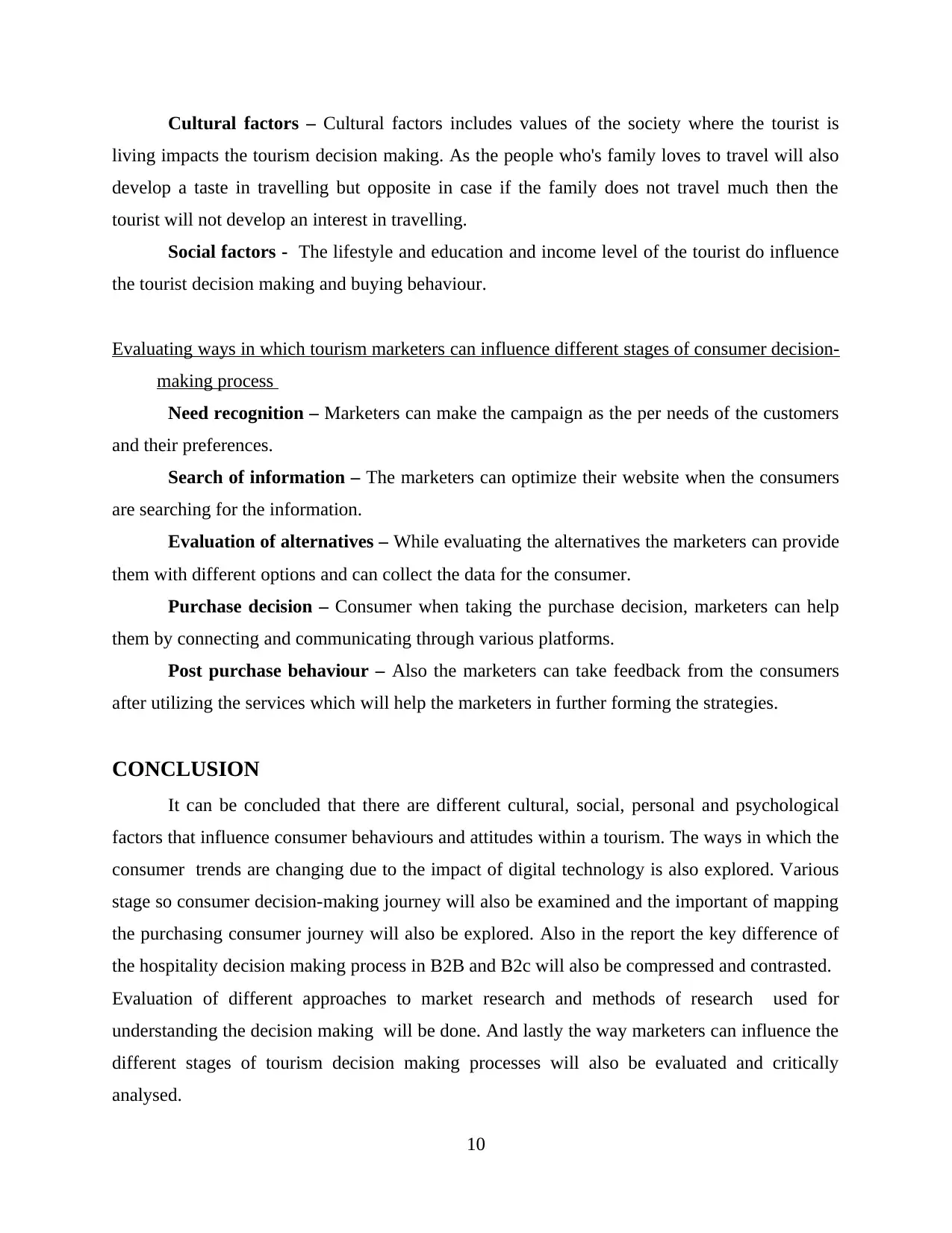
Cultural factors – Cultural factors includes values of the society where the tourist is
living impacts the tourism decision making. As the people who's family loves to travel will also
develop a taste in travelling but opposite in case if the family does not travel much then the
tourist will not develop an interest in travelling.
Social factors - The lifestyle and education and income level of the tourist do influence
the tourist decision making and buying behaviour.
Evaluating ways in which tourism marketers can influence different stages of consumer decision-
making process
Need recognition – Marketers can make the campaign as the per needs of the customers
and their preferences.
Search of information – The marketers can optimize their website when the consumers
are searching for the information.
Evaluation of alternatives – While evaluating the alternatives the marketers can provide
them with different options and can collect the data for the consumer.
Purchase decision – Consumer when taking the purchase decision, marketers can help
them by connecting and communicating through various platforms.
Post purchase behaviour – Also the marketers can take feedback from the consumers
after utilizing the services which will help the marketers in further forming the strategies.
CONCLUSION
It can be concluded that there are different cultural, social, personal and psychological
factors that influence consumer behaviours and attitudes within a tourism. The ways in which the
consumer trends are changing due to the impact of digital technology is also explored. Various
stage so consumer decision-making journey will also be examined and the important of mapping
the purchasing consumer journey will also be explored. Also in the report the key difference of
the hospitality decision making process in B2B and B2c will also be compressed and contrasted.
Evaluation of different approaches to market research and methods of research used for
understanding the decision making will be done. And lastly the way marketers can influence the
different stages of tourism decision making processes will also be evaluated and critically
analysed.
10
living impacts the tourism decision making. As the people who's family loves to travel will also
develop a taste in travelling but opposite in case if the family does not travel much then the
tourist will not develop an interest in travelling.
Social factors - The lifestyle and education and income level of the tourist do influence
the tourist decision making and buying behaviour.
Evaluating ways in which tourism marketers can influence different stages of consumer decision-
making process
Need recognition – Marketers can make the campaign as the per needs of the customers
and their preferences.
Search of information – The marketers can optimize their website when the consumers
are searching for the information.
Evaluation of alternatives – While evaluating the alternatives the marketers can provide
them with different options and can collect the data for the consumer.
Purchase decision – Consumer when taking the purchase decision, marketers can help
them by connecting and communicating through various platforms.
Post purchase behaviour – Also the marketers can take feedback from the consumers
after utilizing the services which will help the marketers in further forming the strategies.
CONCLUSION
It can be concluded that there are different cultural, social, personal and psychological
factors that influence consumer behaviours and attitudes within a tourism. The ways in which the
consumer trends are changing due to the impact of digital technology is also explored. Various
stage so consumer decision-making journey will also be examined and the important of mapping
the purchasing consumer journey will also be explored. Also in the report the key difference of
the hospitality decision making process in B2B and B2c will also be compressed and contrasted.
Evaluation of different approaches to market research and methods of research used for
understanding the decision making will be done. And lastly the way marketers can influence the
different stages of tourism decision making processes will also be evaluated and critically
analysed.
10
Paraphrase This Document
Need a fresh take? Get an instant paraphrase of this document with our AI Paraphraser
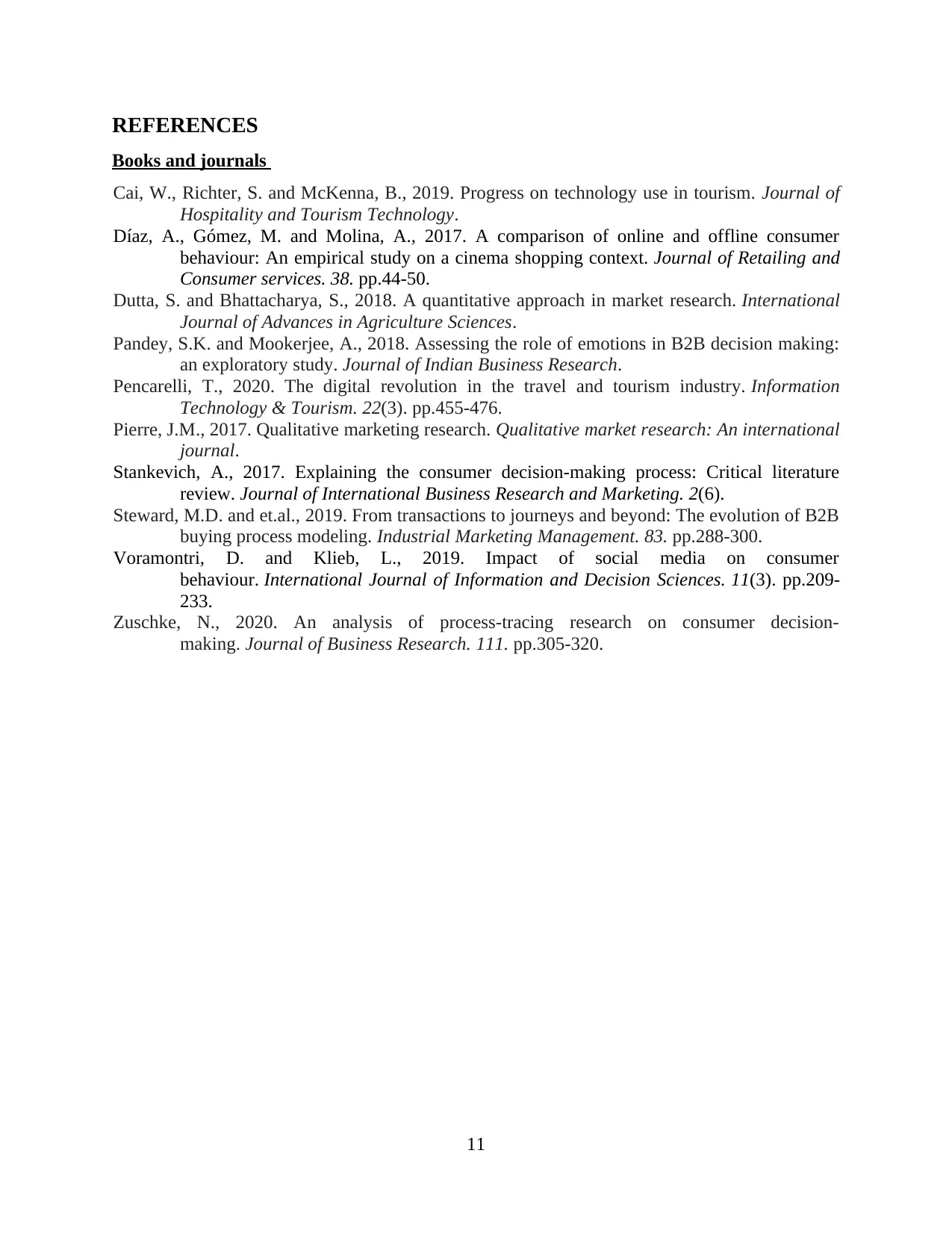
REFERENCES
Books and journals
Cai, W., Richter, S. and McKenna, B., 2019. Progress on technology use in tourism. Journal of
Hospitality and Tourism Technology.
Díaz, A., Gómez, M. and Molina, A., 2017. A comparison of online and offline consumer
behaviour: An empirical study on a cinema shopping context. Journal of Retailing and
Consumer services. 38. pp.44-50.
Dutta, S. and Bhattacharya, S., 2018. A quantitative approach in market research. International
Journal of Advances in Agriculture Sciences.
Pandey, S.K. and Mookerjee, A., 2018. Assessing the role of emotions in B2B decision making:
an exploratory study. Journal of Indian Business Research.
Pencarelli, T., 2020. The digital revolution in the travel and tourism industry. Information
Technology & Tourism. 22(3). pp.455-476.
Pierre, J.M., 2017. Qualitative marketing research. Qualitative market research: An international
journal.
Stankevich, A., 2017. Explaining the consumer decision-making process: Critical literature
review. Journal of International Business Research and Marketing. 2(6).
Steward, M.D. and et.al., 2019. From transactions to journeys and beyond: The evolution of B2B
buying process modeling. Industrial Marketing Management. 83. pp.288-300.
Voramontri, D. and Klieb, L., 2019. Impact of social media on consumer
behaviour. International Journal of Information and Decision Sciences. 11(3). pp.209-
233.
Zuschke, N., 2020. An analysis of process-tracing research on consumer decision-
making. Journal of Business Research. 111. pp.305-320.
11
Books and journals
Cai, W., Richter, S. and McKenna, B., 2019. Progress on technology use in tourism. Journal of
Hospitality and Tourism Technology.
Díaz, A., Gómez, M. and Molina, A., 2017. A comparison of online and offline consumer
behaviour: An empirical study on a cinema shopping context. Journal of Retailing and
Consumer services. 38. pp.44-50.
Dutta, S. and Bhattacharya, S., 2018. A quantitative approach in market research. International
Journal of Advances in Agriculture Sciences.
Pandey, S.K. and Mookerjee, A., 2018. Assessing the role of emotions in B2B decision making:
an exploratory study. Journal of Indian Business Research.
Pencarelli, T., 2020. The digital revolution in the travel and tourism industry. Information
Technology & Tourism. 22(3). pp.455-476.
Pierre, J.M., 2017. Qualitative marketing research. Qualitative market research: An international
journal.
Stankevich, A., 2017. Explaining the consumer decision-making process: Critical literature
review. Journal of International Business Research and Marketing. 2(6).
Steward, M.D. and et.al., 2019. From transactions to journeys and beyond: The evolution of B2B
buying process modeling. Industrial Marketing Management. 83. pp.288-300.
Voramontri, D. and Klieb, L., 2019. Impact of social media on consumer
behaviour. International Journal of Information and Decision Sciences. 11(3). pp.209-
233.
Zuschke, N., 2020. An analysis of process-tracing research on consumer decision-
making. Journal of Business Research. 111. pp.305-320.
11
1 out of 11
Related Documents
Your All-in-One AI-Powered Toolkit for Academic Success.
+13062052269
info@desklib.com
Available 24*7 on WhatsApp / Email
![[object Object]](/_next/static/media/star-bottom.7253800d.svg)
Unlock your academic potential
Copyright © 2020–2025 A2Z Services. All Rights Reserved. Developed and managed by ZUCOL.




